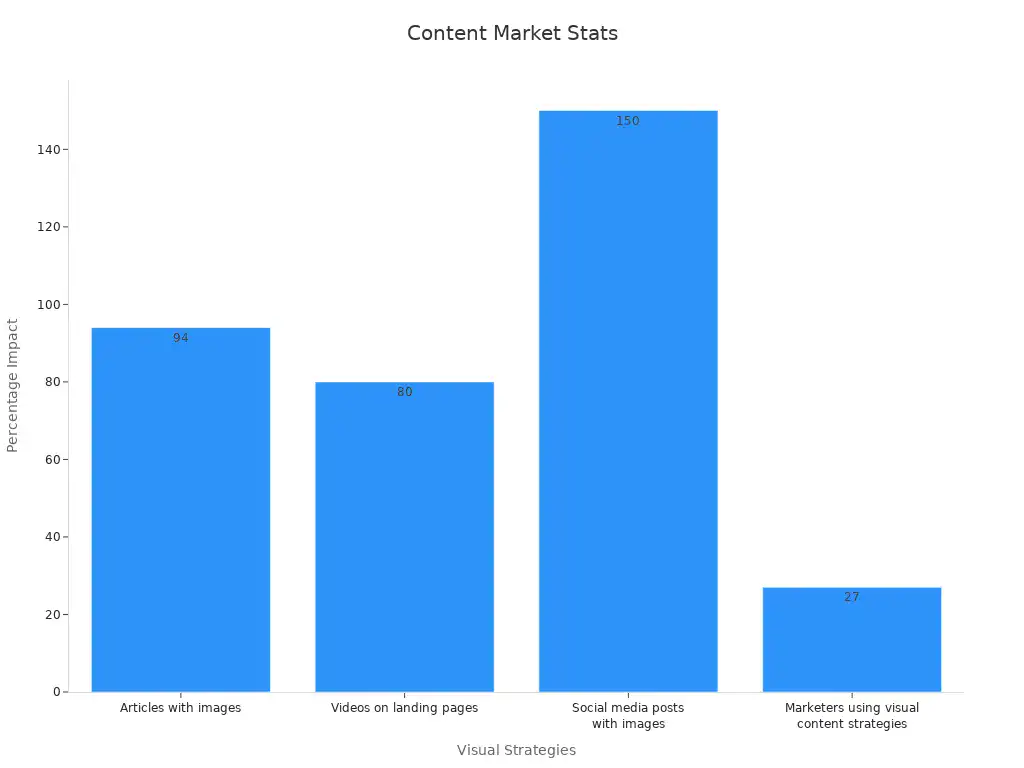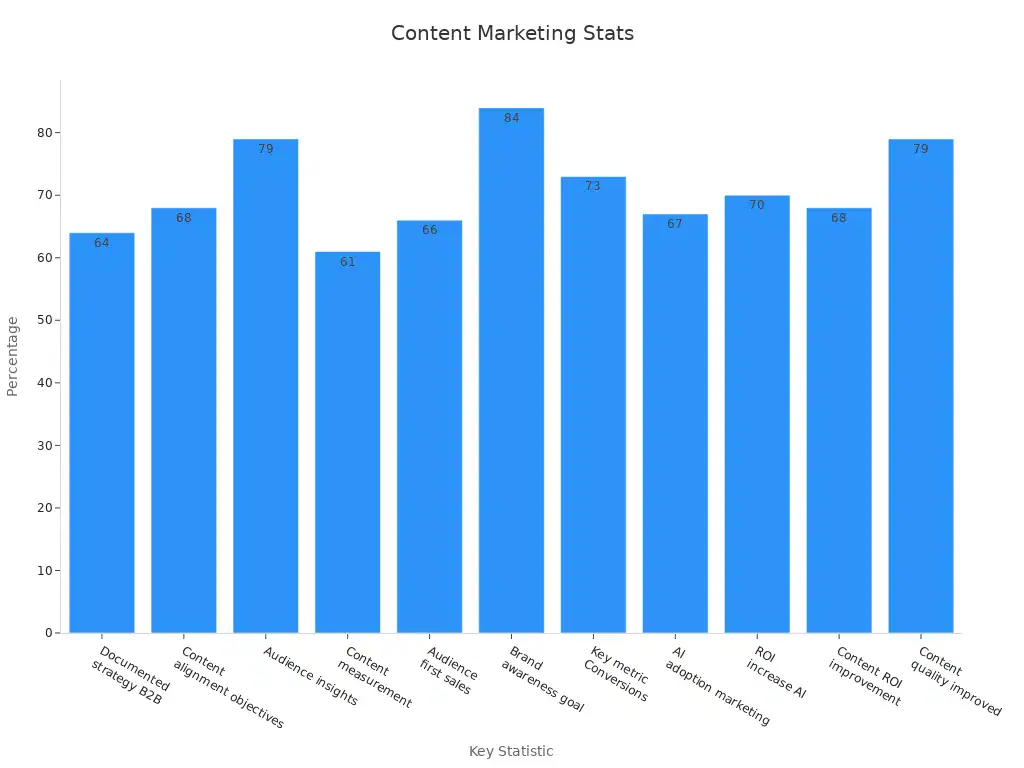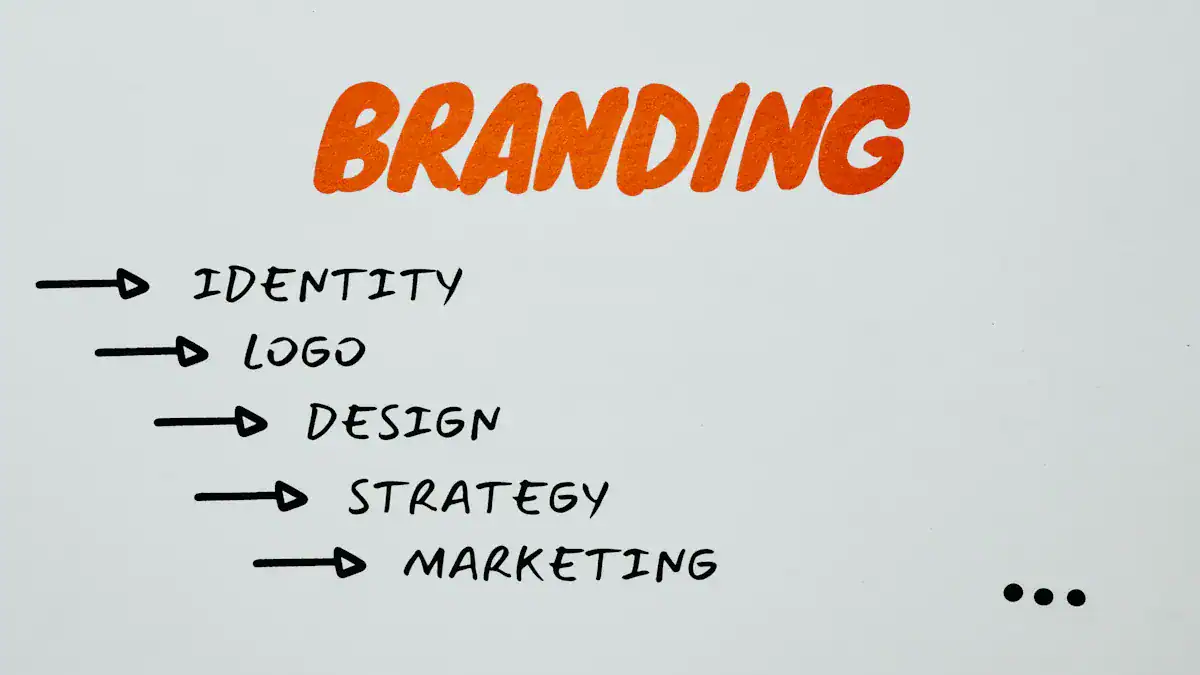Content marketing uses valuable information to attract and keep an audience online. Companies choose this strategy because it offers more leads and better results than traditional marketing.
For example, content marketing generates three times more leads and costs 62% less than older methods.
Website conversion rates are almost six times higher for those using content marketing.
Businesses see higher customer retention when they deliver content with value, relevance, and consistency. Salesforce saw a 20% increase in engagement and better retention by sharing research-driven reports and live-streamed content.
Key Takeaways
Content marketing attracts more leads and costs less than traditional marketing, helping businesses grow faster and build trust.
Creating valuable, consistent content like blogs, videos, and social media posts keeps audiences engaged and improves brand loyalty.
Knowing your target audience and setting clear goals helps create content that meets their needs and supports business success.
Using the 3 C’s—Creation, Curation, and Conversation—builds stronger connections and boosts content marketing results.
Measuring performance and adjusting strategies regularly ensures content stays effective and drives real business growth.
Why Content Marketing
Benefits
Content marketing helps businesses reach more people and grow faster. Companies with blogs get 67% more leads than those without. B2B marketers report that 67% see more engagement and leads from their efforts. Branded videos convince 88% of viewers to make a purchase. Real-world examples show strong results:
Evidence Type | Data / Example | Explanation / Business Impact |
|---|---|---|
Lead Generation | Businesses with blogs get 67% more leads than companies without blogs | Attracts potential customers and generates leads. |
Engagement & Leads | 67% of B2B marketers report increased engagement and lead generation | Improves interaction and sales opportunities. |
Purchase Influence | 88% of people credit branded videos for convincing purchase decisions | Influences consumer buying behavior. |
Example – Help Scout | Blog strategy generates 400,000+ monthly organic visits | Drives significant organic traffic and visibility. |
Example – Gallant | Pet marketing content grows to 80,000 monthly organic visits valued at $64,500 | Builds brand credibility and valuable traffic. |
Example – Ahrefs | Ranks #2 for competitive keywords, driving conversions | Converts visitors into customers through strategic content. |
Business Benefits | Increases visibility, authority, loyalty, and ROI | Supports multiple business goals beyond just traffic or leads. |
Audience Engagement
Engaging content keeps people interested and builds trust. Businesses that publish 16 or more blog posts each month get 3.5 times more traffic than those with fewer posts. Articles with images receive 94% more views. Videos on landing pages can boost conversion rates by 80%. Social media posts with images get 150% more engagement. The chart below shows the impact of visual content marketing:

Personalized experiences also matter. Netflix uses AI to suggest shows, which influences 80% of what people watch. Brands that engage customers across channels keep up to 89% of them, compared to only 33% for those that do not.
Inbound Approach
Content marketing uses an inbound approach. This means businesses attract customers by sharing helpful information. Responding to leads quickly increases the chance of booking a meeting by 100 times. Seventy-eight percent of customers buy from the company that replies first. Inbound lead qualification helps sales teams focus on the right people and shortens the sales cycle. Companies that use this approach see better sales forecasting and more cross-sell opportunities. This method helps brands build trust and long-term relationships with their audience.
Content Marketing Strategy
A strong content marketing strategy helps businesses reach their goals and connect with the right people. This section explains what makes a good strategy and how companies can use it to succeed.
Goals
Setting clear goals is the first step in any content marketing plan. Companies need to decide what they want to achieve. These goals should be specific and measurable. Many businesses focus on increasing brand awareness, generating leads, or boosting sales. Some aim to improve customer loyalty or educate their audience.
Tip: Goals work best when they match the company’s main business objectives.
Many companies use numbers to track their progress. Here are some common ways to measure success:
Bounce rate and conversion rate
Lead generation and revenue from content
Brand awareness and engagement metrics
Cost per acquisition
Other important indicators include SEO keyword rankings, organic traffic, video completion rates, and social media engagement. Companies often review these numbers every month or quarter to see what works best.
Key Statistic | Percentage | Strategic Insight |
|---|---|---|
Documented content marketing strategy among top B2B marketers | Having a documented strategy correlates strongly with success, emphasizing the need to formalize goals, audience personas, content themes, and measurement plans. | |
Alignment of content with business objectives | 68% | Successful marketers ensure content supports organizational goals, highlighting the importance of strategic content mapping. |
Understanding the audience | 79% | Top performers attribute success to deep audience knowledge, underscoring the need for detailed buyer personas and ongoing audience research. |
Effective measurement of content performance | 61% | High performers measure and report content impact, stressing the importance of KPIs and performance frameworks. |
Prioritizing audience needs over sales goals | 66% | Creating value-driven content that addresses audience pain points is critical for engagement and trust. |
Use of brand awareness as a content goal | 84% | Brand awareness remains a primary objective, alongside lead generation and nurturing, guiding content goal setting. |
Use of conversions as a key metric | 73% | Tracking conversions ties content performance directly to business results, reinforcing measurement focus. |
Adoption of AI in content marketing | 67% | Growing use of AI tools enhances content ideation, SEO, personalization, and ROI. |
ROI increase from AI use | 70% average increase | Demonstrates significant impact of AI on content marketing effectiveness. |
Increased content marketing ROI due to AI | 68% | Further supports AI’s role in improving content marketing outcomes. |
Improvement in content quality thanks to AI | 79% | AI tools help create higher-quality content, improving efficiency and effectiveness. |

Target Audience
Knowing the target audience is key to a successful content marketing strategy. Companies use data from their websites, social media, and customer feedback to learn about their audience. They look at age, interests, and online behavior to create detailed profiles.
A simple process helps businesses find and reach the right people:
Collect data from website analytics, social media, and customer surveys.
Group people by age, interests, and how they interact with content.
Use tools like customer data platforms and AI analytics to spot trends and improve campaigns.
Follow four steps: Define the audience, Plan the content, Optimize based on results, and Evaluate success.
Check data often to see if the audience is the right size and quality, then adjust as needed.
Note: Companies that understand their audience well create more engaging and effective content.
The 3 C’s
The 3 C’s—Creation, Curation, and Conversation—form the core of modern content marketing.
Creation: Companies make original content like blog posts, videos, or stories. Microsoft’s “Stories” blog uses storytelling to build trust and connect with readers. AI tools help teams come up with ideas and drafts, making it easier to keep content fresh and interesting.
Curation: Businesses share useful content from other sources that match their brand. AI helps find trending topics and the best articles to share. This keeps the audience informed and shows that the company knows what matters.
Conversation: Brands talk with their audience through comments, social media, and campaigns. The Red Cross’s #DoingMyPart campaign encouraged people to share their stories, which increased engagement. Coca-Cola’s “Share a Coke” campaign used names on bottles to start conversations and make people feel special.
Component | Explanation | Example Companies | Impact on Content Marketing Performance |
|---|---|---|---|
Creation | AI-assisted generation of content ideas and drafts, allowing creative teams to focus on brand voice and emotional intelligence. | Buffer, HubSpot | Enables consistent production of high-quality, relevant content that resonates emotionally with audiences. |
Curation | Use of AI to analyze large datasets to identify trending and engaging content, tailored to align with brand messaging. | Buffer, HubSpot | Enhances content relevance and audience targeting by delivering curated, timely content. |
Conversation | Engagement through interactive elements and real-time feedback, fostering dialogue between brand and audience. | Buffer, HubSpot | Creates personalized and immersive customer experiences, increasing user engagement and loyalty. |
Companies that use all three C’s create stronger connections with their audience and see better results from their content marketing.
Customer Journey

Understanding the customer journey helps marketers create content that matches each stage of the buying process. Mapping the journey gives a clear view of how people interact with a brand, from first learning about it to making a purchase. This approach helps teams focus on what matters most and improves the overall customer experience.
Awareness
The awareness stage introduces a brand to new people. Marketers use content to educate and attract attention. Social media, search engines, and display ads help reach a wide audience. Content marketing stands out as a cost-effective way to generate leads and build trust. For example, 87% of B2B marketers say content marketing creates demand and leads. Video content also plays a big role, with 58% finding it most effective for lead generation. Brands that focus on awareness see lower customer acquisition costs and higher brand recall.
Statistic | Impact on Awareness |
|---|---|
87% of B2B marketers say content marketing generates demand and leads | Attracts initial interest |
Content marketing costs 62% less and generates 3x more leads than traditional marketing | Cost-effective and high volume |
Builds confidence early |
Consideration
During consideration, customers compare options and look for detailed information. Marketers provide guides, case studies, and how-to videos to help buyers make informed choices. Product comparison guides can increase sales conversion rates by up to 30%. Case studies and reviews show real results, while webinars and ebooks offer in-depth knowledge. Social proof, such as peer reviews, influences 61% of consumers at this stage. Educational content builds trust and helps customers feel confident about their choices.
Product comparison guides and case studies
How-to videos and tutorials
Ebooks, webinars, and tip sheets
Reviews and testimonials
Decision
The decision stage focuses on helping customers take action. Marketers use content like live demos, free trials, and consultations to remove doubts. Case studies and user guides provide proof and practical tips. Interactive tools, such as ROI calculators, let buyers see personal benefits. Free demos often lead to high conversion rates by giving hands-on experience. Marketers track conversion rates, cart abandonment, and sales to measure success. This stage aims to make the buying process smooth and build lasting loyalty.
Consultations and estimates
Product user guides and ROI calculators
Case studies and comparison guides
Types of Content Marketing

Blogs
Blogs help businesses share ideas, news, and guides with their audience. They attract visitors and keep them engaged. Companies use blogs to answer questions and solve problems.
Unique visitors show how many people read the blog.
Sessions track how often people visit.
New sessions reveal if the blog attracts new readers.
Average time on page shows if readers find the content helpful.
Bounce rate tells if visitors leave quickly.
Pages per session measure how much readers explore.
SEO metrics, like keyword rankings, show how well the blog performs in search engines.
Shares, likes, and comments reflect user engagement.
A blog with strong content can increase brand awareness and customer loyalty. Some companies see a 5% conversion rate from blog leads to customers and an 80% retention rate from engaged readers.
Videos
Videos capture attention and explain ideas quickly. Many people prefer watching videos over reading text. Videos can show products, teach skills, or share stories.
Metric | Impact |
|---|---|
Consumer Influence | High percentage buy after watching videos |
Website Performance | Longer visitor duration, better SEO |
Social Media Engagement | Higher likes, shares, and comments |
Business Outcomes | More leads, sales, and ROI |
Interactive/Personalized Video | Boosts engagement and conversions |
Videos help brands build trust and keep viewers interested. Marketers report more leads and sales when they use videos in their content marketing.
Infographics
Infographics use pictures and charts to explain complex ideas.
Over half of marketers say visual content is crucial.
Infographics make data easy to understand.
Viewers remember 65% of information from visuals, compared to 10% from audio.
Posts with infographics get up to 65% more engagement.
Infographics are shared three times more than other content types.
They improve SEO by earning backlinks and ranking in image searches.
Infographics help people learn quickly and share information with others.
Podcasts
Podcasts let brands speak directly to their audience.
Over 90% of podcast ads use dynamic targeting.
81% of listeners pay attention to ads, and 95% take action after hearing one.
42% of Americans trust podcast ads more than TV or newspaper ads.
Millennials and Gen Z are the largest podcast audiences.
Podcasts deliver a 4.2x return on ad spend.
Listeners show strong loyalty, with many tuning in to new episodes within 24 hours.
Podcasts build trust and reach new groups, especially younger and multicultural listeners.
Social Media
Social media connects brands with people everywhere.
Engagement metrics include likes, comments, shares, retweets, and clicks.
Impressions and reach show how many people see the content.
Customer satisfaction scores and response times reflect service quality.
Higher engagement rates increase content visibility.
Analytics tools help track and improve social media strategies.
Social media helps brands interact with customers and grow their online presence.
Note: Different types of content marketing work best at different stages. Educational content works well when awareness is low, while comparative content helps in crowded markets. Companies like Hotjar and SessionStack use both to attract and convert users.
Best Practices
Consistency
Consistency stands as a key factor in successful content marketing. Brands that keep their messaging, tone, and publishing schedules steady build trust with their audience. Leading companies like HubSpot and Coca-Cola show that regular content leads to higher engagement and loyalty. Consistent branding also improves search rankings and helps people recognize a brand quickly. Studies show that businesses with steady branding can be valued up to 20% higher. Inconsistent efforts often confuse audiences and weaken trust.
Tools such as content calendars, style guides, and platforms like Trello or Hootsuite help teams stay on track.
What makes consistency effective in content marketing?
Establish brand guidelines for a unified look and feel.
Use content calendars to plan and schedule posts.
Track key metrics like conversion rates and audience reach.
Test different content elements to see what works best.
Report results based on business impact.
Review long-term trends and audience segments.
Adjust strategies based on regular data reviews.
Measurement
Measurement helps brands understand what works in their content marketing. Analytics tools give clear data on customer behavior and campaign results. Marketers use dashboards to see important numbers like engagement, conversion rates, and time spent on content. These insights show which topics and formats perform best.
Channel trackers like Google Analytics monitor different marketing channels.
Integration with CRM and ad platforms provides a full view of performance.
Data analysis uncovers trends, strengths, and weaknesses.
A/B testing helps optimize content for better results.
Dashboards make it easy to share findings with teams.
Measurement turns content marketing into a tool for growth by linking content to real business outcomes.
Overcoming Challenges
Many brands face challenges in content marketing, such as limited reach or too much focus on one type of content. Case studies show that companies like Domino’s Pizza and McDonald’s use analytics to solve problems and improve results. For example, Domino’s reduced delivery times by 20% with route optimization, while McDonald’s increased engagement by 30% using real-time data.
Company | Challenge | Solution | Result |
|---|---|---|---|
Domino’s | Delivery efficiency | Route analytics, quality tracking | |
McDonald’s | Low engagement | Real-time analytics | 30% more engagement |
Zara | Inventory costs | Predictive analytics | 20% cost reduction |
Brands that use data-driven solutions overcome obstacles and see measurable improvements in their content marketing.
Content marketing gives businesses a way to build trust, grow their audience, and increase sales over time. Companies see better results when they track key metrics like website traffic, conversion rates, and social media engagement.
Improved SEO rankings and brand awareness show the long-term value of a strategic, audience-focused approach.
Consistent, high-quality content helps brands stand out and connect with customers.
To get the best results, companies should:
Analyze their audience and adjust content often.
Use new tools and trends to keep strategies fresh.
FAQ
What is content marketing?
Content marketing is a way for businesses to share helpful information. They use blogs, videos, and social media to reach people. This method helps companies build trust and attract new customers.
What types of content work best for marketing?
Different types of content work well for different goals. Blogs, videos, infographics, podcasts, and social media posts all help brands connect with their audience. Companies choose the type that fits their message and audience best.
What makes content marketing different from traditional marketing?
Content marketing focuses on giving value. It does not interrupt people with ads. Instead, it attracts them by sharing useful information. This approach builds stronger relationships and trust over time.
What are the main benefits of content marketing?
Content marketing helps brands get more leads, improve search rankings, and build loyalty. It costs less than traditional ads. Companies see better results when they share valuable and relevant content.
What tools help with content marketing?
Many companies use tools like Google Analytics, Hootsuite, and Canva. These tools help plan, create, and measure content. They make it easier to track results and improve future campaigns.
